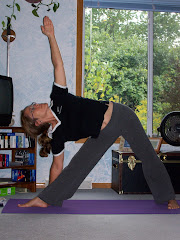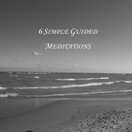This was written last week after the 2d day of training in Wise Sequencing with Rod Stryker.
Why "Ayurveda" in the title of this entry? Rod makes great use Ayurvedic (Vedic medicine) knowledge and wisdom. A matter of fact, the recommending reading for this class is Yoga and Ayurveda by Frawley.
Here were my thoughts after day 2......
After practicing for almost 10 years, today was my deepest and easiest forward bend. Pashimottansana (seated forward stretch or stretching the West side) has like lying on a bed. I felt as if I could have stayed there for hours.
Perhaps, this method of sequencing (vinyasa krama) is really magical. Time will tell. Ever since injuring my low back a few years ago, I have been very careful in forward bends. Today I threw caution to the wind and decided to test out Rod Stryker’s thoughts on wise progression of asanas to see how my back would handle it.
The lesson: Wise progression of asanas can make or break a practice.
The 3 hour morning session consisted of talking about the true meaning of Yoga—adhikara and remembering the divinity that is part of you—and a forward bend practice. Then we broke for lunch. The 4 hour afternoon session was all sitting—other than 2 bathroom breaks and 10 minutes of asana towards the very end.
This is sitting on the floor! Chairs were available in the back, but I’m a front row kind of person—being short and all.
Amazingly, I’m very glad for this. I have been to a number of teacher trainings, and the biggest complaint I have is there is too much asana. As another gal today pointed out, we can practice on our own; we’re here to learn.
The lesson: What feels good, isn’t always what's best for you.
As wonderful as an experienced asana practice can feel, a big part of training is just that—training! To challenge my body & mind in various asanas won’t provide me with as much wisdom and knowledge that I’d like to gain from a workshop.
So, lecture and discussion is very important. For me, it just might be the most important. With that said, being led through a skillfully created flow of postures, really shows the theory put into practice.
In summary, sitting for 4 hours to review how to sequence a class, may be hard on the body, but to experience the sharing of great wisdom is worth it—to me, anyway. Overall, Rod is doing a decent job of opening with some philosophy in the AM, then asana, lunch, and the afternoon is mostly lecture and reviewing the morning’s asanas. [BTW, this continued to be the format for the full 5 days.] This really helps to get things in the body and then solidify them in the mind.
With that said, one technique that he suggests to activate the brain to retain more info—which I’m finding very useful—is after a practice, draw stick figures of the asanas and make notes about what you liked or didn’t like. Mr. Stryker makes this very easy by providing a list of the sequence.
Great idea, now if I could just be organized enough to know the asanas ahead and write them all down for my own students…..
The lesson: Work with the body and the mind, so eventually you can move beyond them both.
Namaste,
Kris
www.TotalHealthYoga.com
Thursday, May 24, 2007
Subscribe to:
Post Comments (Atom)



No comments:
Post a Comment